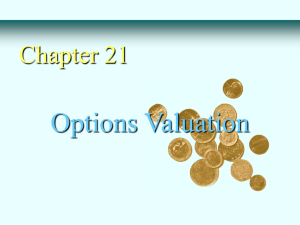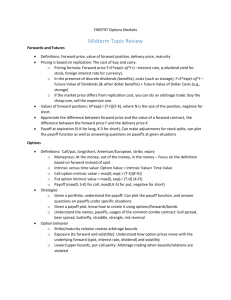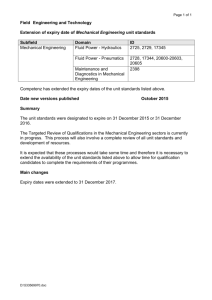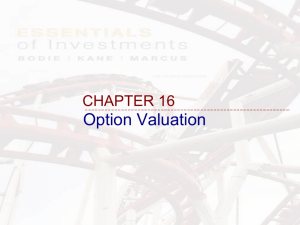Maths & Money A story of modern Finance
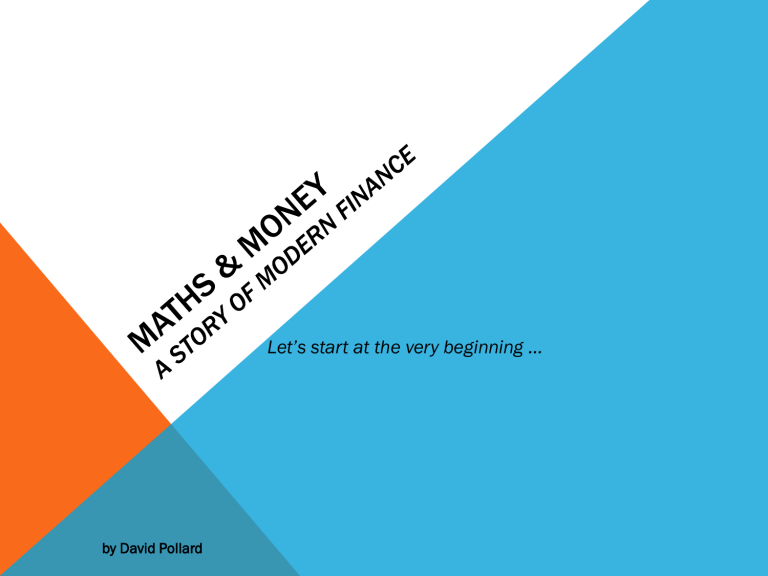
by David Pollard
Let’s start at the very beginning …
Let’s start at the very beginning,
A very good place to start.
When you read you begin with A, B, C,
When you Quant you begin with Black-Scholes Theory
!
2
BLACK & SCHOLES THEORY!
Fischer Black
Partner at Goldman Sachs - most (in)famous investment bank?
The Quants’ Quant – a legend
Myron Scholes
Nobel prize winner in Economics with Merton in 1997
Partner at Long Term Capital Management in 1998
‘When Genius failed’ (the first time!)
Let’s understand this
Price of a 'call option': c
=
S
×
N ( d
1
)
-
X
×
e
rT
×
N ( d
2
)
3
THE GUIDE SLIDE
Future Value, Present Value and Discounting
Arbitrage
Expected Return
Stocks & Shares and Options
Evolution of stock prices and the stock price process
Physicists in Finance
Philosophy!
4
FUTURE VALUE QUESTION
Question : What is better, a dollar now or a dollar in one year’s time?
Don’t worry about theft etc.!
In fact we always assume Integrity in financial calculations
“No criminals” in Regulated financial markets
5
FUTURE VALUE ANSWER
Answer : A dollar now because it can be invested to earn a return
Becomes more than a dollar in a year’s time
If nominal interest rates are positive
as they usually are
Real interest rates are another matter entirely!
Real rate = Nominal rate – rate of Inflation
6
0.8
0.6
0.4
0.2
1.2
1.0
0m
FUTURE VALUE
$ Future Value in one year
FutureValue
= ( )
1
$ Future Value every quarter
1.2
12m
1.0
0.8
0.6
0.4
0.2
If r=10% = 0.1
Future Value is 1.(1+0.1) = $1.10c
FutureValue
=
æ
ææ
+ r
4
æ
ææ
4
0m
Compounding period
3m 6m 9m
1.2
1.0
0.8
0.6
0.4
0.2
12m
$ Future Value every month
0m 1m 2m 3m 4m 5m 6m 7m 8m 9m 10m 11m 12m
FutureValue
=
ææ
+ r
12
æ
ææ
12
7
FUTURE VALUE – The formula
As compounding period gets smaller and smaller the Future Value factor in one year becomes ...
lim n
æ
æ
ææ
1
+ r n
æ
ææ n
But, in the limit of continuous compounding, this is the mathematical definition of the Exponential
Function lim n
æ
æ
ææ
1
+ r n
æ
ææ n
= e r
So future value of a dollar is
1
e r
Conversely the Present Value today of a dollar in T year’s time is the exponential with negative argument … e
rT
Discounting c
S
N ( d
1
)
X
e
rT
N ( d
2
)
8
Future Values at 20 and 50
ARBITRAGE
1.4
1.2
1.0
Different interest rates present an ‘arbitrage’ opportunity
Bank A quotes 20% one year rate
Bank B quotes 50% one year rate
The arbitrage trade
0.8
0.6
0.4
0.2
0m
Borrow $1M from Bank A at 20% and immediately lend it to Bank B at 50%
Riskless profit after 1 year : $1.5M - $1.2M = $300,000!
Interest rates must be the same unless they represent different levels of risk
There is only one ‘risk-free’ rate
All discounting is done at the (unique) risk free rate
Risk neutral valuation
Black and Scholes used these arbitrage arguments to determine the value of r in
12m
9
EXPECTED RETURN
Opportunity came to my door,
When I was down on my luck
In the shape of an old friend,
With a plan guaranteed
Have $1,000,000 to invest and two options;
1) Put it on the bank where, with 30% returns, it becomes $1,300,000 in a year’s time
2) An old friend asks you to invest in a gold mining project which, she says, will make
$15,000,000 in a year!
What to do?
Compare the ‘Expected Future Value’
1) Probability of success = 100% so
Expected Future Value = $1.3M as before
2) You find out that only 2 of the 20 claims near you friend’s have struck gold
Probability of success is 2/20 = 10%
Expected Future Value is (1/10) * $15M + (9/10)*$0 = $1.5M
Go with the Gold!
Statistics health warning!
10
EXPECTED RETURN
If we have a number of uncertain outcomes then the probability weighted future value is what we should expect
Example:
Future value of $25 with probability 17%
Future value of $40 with probability 5%
Expected Future Value $25*0.17 + $40*.05
EFV = $6.25
0.4
0.3
2 outcomes with probabilities from a statistical distribution
0.2
Question: How come EFV less than $25?
Answer: All other outcomes have $0 Future Value 0.1
25 .17
40 .05
11
STOCKS & SHARES
Ownership of a ‘share (certificate)’ literally gives you a share of the value of a company
Companies raise money (equity) for their business by ‘issuing shares’ i.e. They sell a part of the company to investors in return for working capital
Companies return some of their profits to investors by ‘paying dividends’ to shareholders at regular intervals
Buying and selling of the shares of big companies is usually done in an organised way on an official stock exchange (the GASCI in Guyana)
If a company does well its share price rises over time
The market value of all outstanding shares is an important measure of a company’s worth
12
OPTIONS – SIMPLE DERIVATIVES
Suppose you like company A and want to buy shares in it but at some time in the future
(maybe you don’t have enough cash right now)
What you need is an option (literally) to buy Company A’s shares
Calls
Puts
A ‘call option’ gives the holder the right but not the obligation to buy a share of the underlying company at a certain date for an agreed price set when the option is ‘struck’
A ‘put option’ gives the holder the right but not the obligation to sell a share of the underlying company at a certain date for an agreed price set when the option is ‘struck’
Specifications require…
Underlying company, expiry, strike price
13
PAYOFF DIAGRAMS
Value of a call option at expiry
(payoff) is shown at top, right
Call payoff = max{(price –strike), 0}
Put payoff is bottom, right
Put payoff = max{(strike – price), 0}
“Hockey stick” diagrams
4
2
0
2
4
20
Value
10
8
6
6
4
2
0
Value
10
8
2
4
20
European call option payoff strike 30
25 30 35
European put option payoff strike 30
25 30 35
40
Stock price at expiry
40
Stock price at expiry
14
STATISTICAL DERIVATION OF CALL PRICE
We know the payoff for a Call option so we know all future values of the option but they all depend on the forward price of the underlying stock
If we can find out the probabilities of each possible forward price then we can use our expected return ideas to: compute the Expected Future Value of the option, discount the Expected Future Value back to today at the risk free rate, to get the Call option price!
So, what about the forward prices of the underlying stock …?
15
FORWARD PRICE STATISTICS
The price return process equation return growth rate dS
=
S m × dt
+ s × dW time-step volatility random change dW is a random draw from N(0,1) * Sqrt ( t)
The forward price solution is ln S
T
~ f
æ
æ ln S
+
æ
ææ m s
2
2
æ
ææ
æ
T , s
T
æ
æ
Forward prices have a lognormal distribution
The world of
AAPL returns and fitted Normal Distribution
20
15
10
5
30
25
0.0025
0.0020
0.0015
0.0010
0.0005
0.04
0.02
0.00
0.02
0.04
Apple 1yr Forward Price distribution
0.06
200 400 600 800 1000 1200
0.08
16
CALL OPTION VALUE
• Value of a call option is the discounted, expected payoff
• (The present value of the doubly shaded area in the plot) c
= e
rT æ
E
[ max( S ( T )
-
X , 0)
]
= e
rT
æ
-æ
æ
max
æ
æ
æ
S
æ e
æ
ææ r
-s
2
2
æ
ææ
T
+ s y T
-
X , 0
æ
æ
æ
æ
1
2 p
æ e
y
2
2
æ dy
2.5
2.0
1.5
1.0
0.5
Expected Payoff of Call option
13 14 15 16 17
17
BLACK-SCHOLES FORMULA
c
=
S
æ
N ( d
1
)
-
X
æ e
rT æ
N ( d
2
) where d
2 d
1
=
= d
1 ln
( )
+
æ
ææ r
+ s
T
s
T s
2
2
æ
ææ
æ
T and
S is the current stock price
X is the strike price
T is the time until expiry r is the risk-free interest rate s
is the volatility of stock price returns
N () is the cumulative normal distribution function
18
A ONE YEAR, CALL OPTION ON DIH
Banks DIH Limited’s shares trade on the GASCI with ticker “DIH”
Most actively traded stock since 2003
Price = 12.5 (18 Jul 2011)
What is the price of a 1 year, European, Call on DIH struck At The Money (i.e. Strike = current Price)?
S = 12.5
K = 12.5
T = 1 year r = 3% (rate on GYD Treasury bills in 2011)
Volatility ( σ) = 15% per annum
Dividend yield ( d ) = 4%
(analysis of DIH price time series)
(we haven’t discussed this but it matters)
Call Option price from Black-
Scholes formula = 66¢
Leverage !
With Calls you can get ‘exposure’ to DIH for 66¢ as opposed to $12.50!
19
BUT …WHY PHYSICISTS IN FINANCE?
Call price formula is a solution of the Black-Scholes Equation
¶ f
¶ t
+ rS
¶ f
¶
S
+
1
2 s
2
S
2
¶ 2 f
¶
S 2
= rf
Physicists familiar with the Heat Equation
¶
¶ f t
- ¶
2
¶
S
2 f
=
0
The Black-Scholes equation can be transformed into the Heat equation
Many solutions (i.e. prices of different derivatives) known to Physics
The new maths!
Ito's Lemma and the mathematics of randomness
20
THE DERIVATIVE ZO0
Pure vanilla Options (Call, Put, FRA)
Low cost
Leverage
American exercise
Can exercise at anytime before expiry
Straddles / strangles
Vanilla combinations that are sensitive to Volatility
Bull/Bear spreads
Vanilla combinations that give up some upside (downside) in return for reduced cost
Barrier options
Options that knock out if the stock price moves too much
21
PHILOSOPHY!
The word "philosophy" comes from the Greek φιλοσοφία ( philosophia ), which literally means "love of wisdom”
”What Traders mean when they talk about things that they can’t figure out a way to make money from!”
Let’s leave mathematical details behind and discuss some general features of the world of Derivatives that Fischer Black, Myron Scholes and Robert Merton have bequeath
22
DERIVATIVES– THE GOOD, …
Hedging & Insurance:
Mr. Ragnauth’s rice sales and Forward Agreements
Eliminate or ‘hedge’ FX risk
Protective Puts
Flexible funding for industry:
Callable bonds / Putable bonds
Risks and exposures:
Derivative equivalents of complex financial structures in corporate assets allow correct evaluation and risk analysis
23
DERIVATIVES– … AND THE BAD
‘Inventing’ derivatives to prove how clever you are:
Double knock-out, geometric asian, cliquet …
Credit Derivatives and the “re-invention” of risk pricing
Investment Banks as the “new, new” Insurance Companies
Did Actuaries really not understand how to price risk?
Contagion and the failure of hedging
From An Essay on Criticism , 1709, Alexander Pope
“ A little learning is a dangerous thing ; drink deep, or taste not the Pierian spring: there shallow draughts intoxicate the brain, and drinking largely sobers us again”.
24
QUIZ: WHAT IS BLACK-SCHOLES?
A. A theory in Finance describing how the future value of money changes
B. The names of two European professors who won the Nobel Prize in
Economics
C. The names of two Jewish professors who developed a pricing formula for the value of options on stocks
D. A civil rights activist who opened access to the US banking system for
Afro-Americans
25
QUIZ: WHAT IS THE EXPECTED RETURN …
… of a $10 return with odds 3/10 and a $20 return with odds 7/10?
A. Very low
B. $17
C. $13
D. $20
26
QUIZ: WHAT IS A EUROPEAN PUT OPTION?
A. A financial asset that must be bought or ‘picked up’ before it has value
B. A right to buy a stock for an agreed price at a specified date in the future
C. A right to sell a stock for an agreed price at a specified date in the future
D. An obligation to sell a stock for an agreed price anytime before a specified date in the future
27
REFERENCES & TOOLS
Books
“Options, Futures and other Derivatives”, (7 th Ed.), J. C. Hull, Prentice Hall, 2008
“Dynamic Asset Pricing Theory”, Darrell Duffie, Princeton University Press, 2001
“When Genius Failed: The rise and fall of Long Term Capital Management”, R.
Lowenstein, Fourth Estate, 2002
“Liar’s Poker”, (reprint), Michael Lewis, W. W. Norton and Co., 2010
“Fool’s gold”, Gillian Tett, Abacus, 2010
Software:
R @ www.R-project.org
Mathematica @ www.wolfram.com/mathematica
Matlab @ www.mathworks.com/products/matlab/
28

